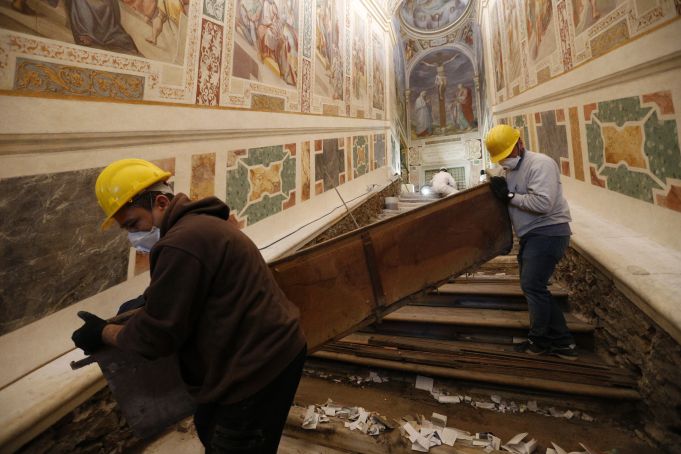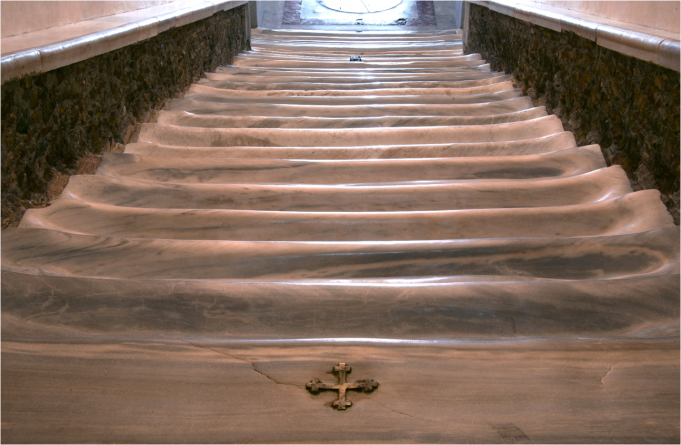Revealing a new secret in Rome: the original marble steps of the Scala Santa.
The modern city of Rome is a complex place for those who live here and especially for those who visit. With its thousands of years of history and its hidden ancient treasures, it continues to surprise.
Among the most historic and unusual places in this city, the Scala Santa (Holy Stair) complex deserves special attention. Standing next to the Basilica of S. Giovanni in Laterano, the focus of Christian Rome from the time of Emperor Constantine, this architectural complex of historical, artistic and religious significance is an important destination.
The Holy Stair itself, said to have been brought from Jerusalem by St Helen in 326 AD, is believed to be the same one that Jesus climbed for his judgement before the Roman prefect Pontius Pilate. It has always been part of the Lateran complex and believers mount it on their knees.
It became an important part of a major pontifical sanctuary commissioned by Pope Sixtus V and built by his architect Domenico Fontana between 1588 and 1590. The building was decorated by a 40-man crew of artists headed by Cesare Nebbia and Giovanni Guerra; among them was Paul Bril, a Flemish painter and printmaker best known for his landscapes.
They also painted every square metre of the walls in the complex, including the central stairway dedicated to the theme of the Passion and two of the five flanking staircases depicting a series of stories from the Old Testament. They lead to the Sancta Sanctorum, the “holiest of holies” – the first papal chapel, which was commissioned by Pope Nicolo III in 1277 and dedicated to the early Roman martyrs.

Since 2000, an international project initially funded by the Getty Foundation has progressively restored the vibrancy and colours of the decorative scheme of the Holy Stair complex. Thanks to the Patrons of the Arts in the Vatican Museums, a team of restorers led by Paolo Violini has worked tirelessly on the treatment of more than 1,700 square metres of frescoes, many unseen for centuries.
The venture, coordinated by Mary Angela Schroth, is now in its final stages and will be finished by Easter 2020. The restoration project will be completed by late March 2020 with a special benediction by Cardinal De Donatis, the archpriest of St John Lateran.
Thanks to the transformation of the Holy Stairs the Passionist Fathers, its custodians, are now able to offer the faithful from all over the world a new reading of the biblical stories from the Passion of Christ and the Old Testament that underline the importance of faith and spiritual salvation.
Between April and July 2019 the walnut wood protection placed over the Holy Stair was removed for the first time since 1723 for the restoration. Thousands of hand-written notes, photographs, ex-votos and coins found beneath the wood, and conserved by the Passionists in the Sanctuary, are being documented for future study.
The 28 marble steps were revealed in their original condition: heavily worn away by countless pilgrims over the centuries, leaving deep furrows in the marble. It became evident that the steps were of the same stone from Asia Minor that is found in other sites in Jerusalem, and that there were subtle differences in the marble colours as well, typical of building in the time of the Roman occupation of Jerusalem.

Three precious mediaeval bronze and marble crosses were found embedded on the second, the eleventh and the last stair, where legend recounted that a drop of Christ’s blood was found. The conservators were struck by the remarkable visual impact of the monument, and Violini was able to convince both the Vatican Museums and the Passionist Fathers to open the uncovered stairs for public viewing from April to July 2019.
The emotional and spiritual response from both pilgrims and the public was overwhelming, increasing the number of visitors three-fold from the usual attendance. Long lines formed at the entrance of the sanctuary to have the privilege of climbing the original stairs on one’s knees. The press coverage was equally strong, garnering attention worldwide, and according the project its just role as one of the most fascinating and unusual destinations in the Eternal City.
In the beauty of the decorations of the past, the ancient tradition of the Scala Santa continues to live in the form of renewed devotion. The entire sanctuary has come to light thanks to the international collaboration of philanthropists, restorers and art historians, as well as the recognition of the faithful and the lay visitor. The conservation and resurrection of the Holy Stair has added a new value to one of the oldest and most revered sites in history.
By Sara Esposito
The Patriarchio, official headquarters of the Roman Church until 1305 when the popes moved to the Vatican, was composed of various buildings. The Holy Stair was part of this ancient complex, as well as the Sancta Sanctorum, the papal chapel commissioned by Pope Nicolas III in 1277. The stairs were moved in 1588 when Pope Sixtus V commissioned a new sanctuary to the Passion of Christ which included the Holy Stair and the chapel of the Sancta Sanctorum at the top of the stairs.
General Info
View on Map
Unveiling Rome's Scala Santa
Piazza di S. Giovanni in Laterano, 14, 00185 Roma RM, Italy

















